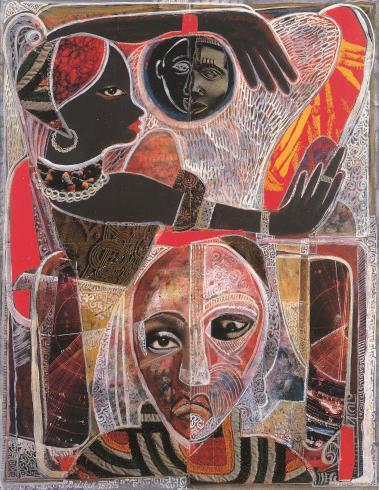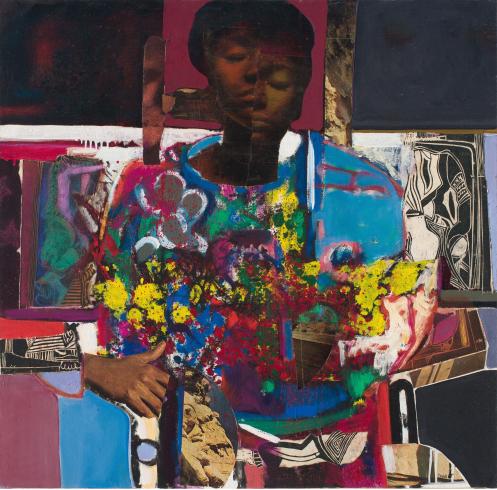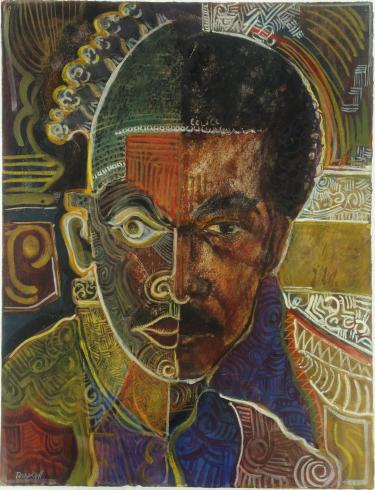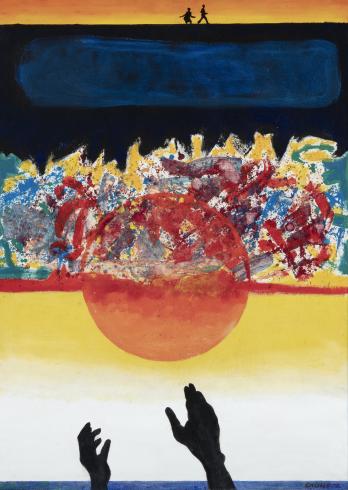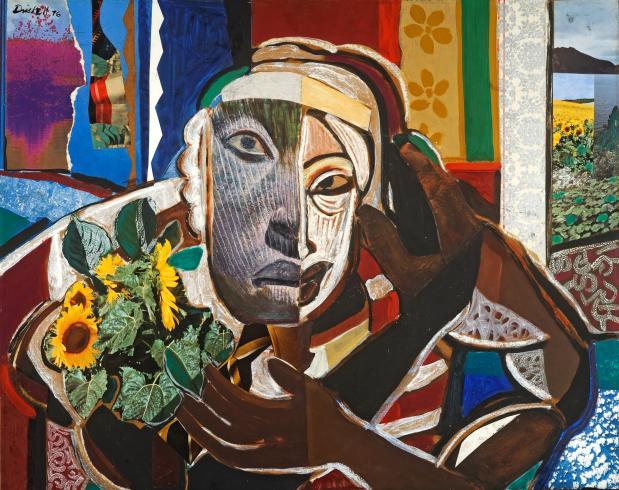Centering Black Art: The Legacy of David Driskell
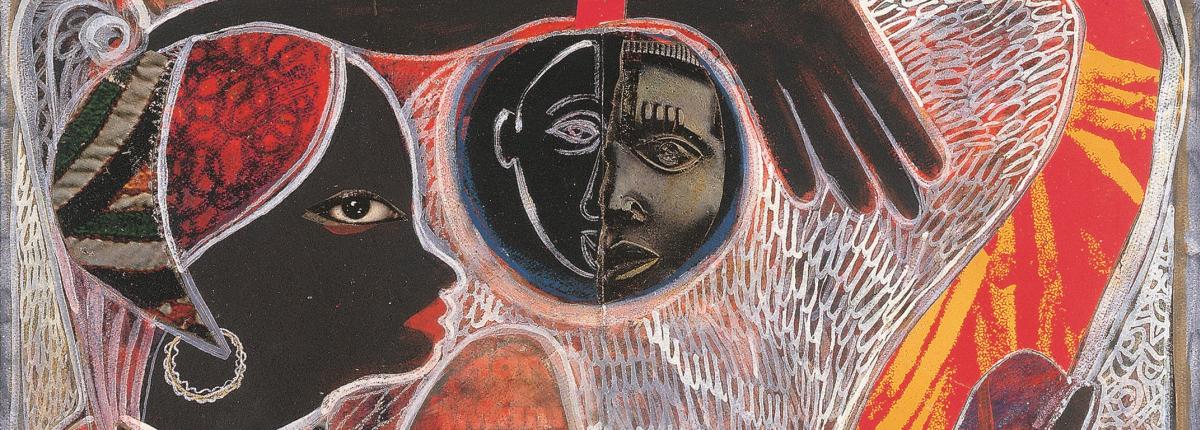
Part 1: Focus In - A Close Look at the Art of David Driskell
- Observe: Have students use Focus in: A Close Look at the Art of David Driskell to:
- Part 1 - individually
- Look at Memories of a Distant Past for one minute.
- Jot down 5 things they noticed about the painting in the space provided.
- As a whole class, ask students what they notice about the painting. Jot down the responses on chart paper.
- Part II - in groups
- Break up students into six groups and assign each a number. Depending on the size of your class, you can assign multiple small groups to the same section of the painting.
- Each group should focus in on a section of the painting and respond to the questions that follow.
- Part 1 - individually
- Reflect: As a whole class, look at the painting in its entirety again. Ask students (you can use the questions to further the discussion or you can put them in a parking lot to return to during or after the lesson):
- What did you notice in the closer look that you did not notice before?
- How do those details help you think about the overall piece in a new way?
- What do you think the message of this piece is? What details from your close study support that message?
- What questions do you still have about the piece and/or the artist?
- Explain: Students will learn more about David Driskell, a world-renowned Black artist and historian. Specifically, they will explore some key themes of Driskell’s art and his legacy as well as become curators of their own exhibition centering art from historically excluded peoples.
Part 2: Who is David Driskell?
Reflect:
- Consider: Share the following quotation from art critic John Yau with students (full article from Medium.com): Driskell never tried to fit in or accommodate his work to prevailing, white, avant-garde styles: he never became a Pop artist, Minimalist, Conceptualist, Pattern and Decoration painter, or Neo-Expressionist. Nor did he ever harken back to some earlier style, as a way of avoiding the confusions of his own time. Rather, he absorbed aspects of various styles and, in the cauldron of his art practice, welded them to his personal and cultural history.”
- Contemplate: Ask students:
- Based on this statement about Driskell’s work, what made Driskell unique?
- Yau says that Driskell took various aspects of many art styles and “welded them to his personal and cultural history.”
- What do you think he means by this statement?
- What might you expect to see as key themes of Driskell’s art based on this quotation?
- Explore: Students should work in pairs to complete the Exploring Themes of Driskell’s Art worksheet.
- Before students work on exploring themes in Driskell’s work, ask students to define “theme.” At this grade level, students should know what theme is, but if not, explain to them that, in this context, it is the subject or topic of the artwork.
- Reflect: As a whole class, discuss answers to the questions on the worksheet. Focus on this big question:
- What are some key themes of David Driskell’s art? Use evidence from the artwork you studied to explain your answer.
Part 3: Driskell’s Legacy
Introduce:
- Driskell not only created art, but he was also a historian. He was particularly interested in studying the contributions of Black people to American art and centering those contributions in discussions about art. He celebrated Black art by: 1) paying homage to Black artists through his own art, 2) curating art by Black artists, and 3) collecting art by Black artists.
- In this lesson, students will examine these first two ways Driskell celebrated Black art and artists.
Centering Black Art:
- Introduce: Romare Bearden was a Black artist born in North Carolina and then grew up in New York City and Pittsburgh. He was best known for his textured collages that often depicted aspects of the Black community as well as the Civil Rights Movement.
- CONNECT: Driskell centered Black artists’ contributions by paying homage to artists he revered in his own artwork, as can be seen in his piece titled Homage to Romare, a tribute to one of his favorite Black artists, Romare Bearden.
- Research: Give students 5-10 minutes to look up Romare Bearden’s artwork. They can also look on the Romare Bearden Foundation website. As they’re reviewing his artwork, they should take note of themes, styles, and/or techniques that are similar throughout his works of art.
- Reflect: Ask students:
- What do you notice in Homage to Romare that suggests Driskell was honoring Bearden?
- Teacher note: Students may point out different symbols; this piece is both a painting and a collage, a technique for which both he and Bearden were known.
Creating a Legacy:
- Introduce: Driskell celebrated Black art through curating exhibitions featuring Black artists across historical time periods.
- Watch: Watch this video on David Driskell speaking about his legacy.
- Reflect: Discuss Driskell’s opening statement from the video: If I had a legacy at all, I would hope that it would be one which would relate to the idea that inclusion and diversity in the arts is one of the healthiest things that could be happening in our culture.
- What do you think Driskell means by this statement? What do you think he is advocating for?
- CONNECT: Dig more deeply into his statement that inclusion and diversity in the arts is one of the healthiest things that could be happening in our culture.
- What does “inclusion” mean to you?
- What does “diversity” mean to you?
- In your previous experiences with viewing art in a museum or elsewhere, which artists come to mind that you learned about? Are the artists from different backgrounds? Do the images in the art often show people or objects from diverse backgrounds?
- What impact would increased “inclusion and diversity in the arts” have on how we discuss and think about art?
Curating Black Art:
- Introduce: Driskell curated a traveling exhibition titled Two Centuries of Black American Art, which was the first comprehensive and historical survey of Black art from the 1750s to the 1950s. To help him do this, his love of history certainly came in handy! From 1976-77, the exhibition was on view in Los Angeles, Atlanta, Dallas, and Brooklyn.
- Tour: Students will work in pairs to go on a “virtual tour” of some of the art featured in this exhibition. They will need a computer or other device to find the artwork online.
- View: Provide students with a copy of the Checklist of Artworks that were included in the exhibition when it was on view at Los Angeles County Museum of Art (LACMA) in 1976.
- Select: Students should select 5 pieces of art by different artists. If they cannot find an artwork from the list online, they should select another one instead.
- Observe: As they examine each artwork, students should jot down their observations in this thought catcher.
- Share: Have each pair of students share about one of the pieces they studied as they went on a historical virtual tour of Two Centuries of Black American Art.
Part 4: Create Your Own Exhibition
- Introduce:
- As noted earlier, one way that Driskell highlighted and celebrated the contributions of Black artists was through his intentionally curated exhibitions. His exhibition Two Centuries of Black American Art was featured nearly 50 years ago.
- Students will curate their own exhibition focused on Black art and artists from the last 70 years (1950s to present), in order to celebrate Black artists since Driskell’s exhibition.
- Teacher note: Acknowledge to students that some artists, such as Alma Thomas, did not define themselves by their race. These artists can still be included in the exhibition.
- Connect: Students should reflect on their own identity and how they define themselves.
- To do this, use the Social Identity Wheel (adapted for use by the Program on Intergroup Relations and the Spectrum Center, University of Michigan).
- After they have self-reflected on their own identities using the Social Identity Wheel, they should select a part of their identity on which they want to focus. As they begin to research artists, they should think specifically about which art resonates with the part of their identity that they selected.
- Research: Students should research artists who resonate with that part of their identity or how they navigate the world. Select 5-10 works of art, created between the 1950s to present, that resonate with them.
- Students can use these lists to get started:
- Create: Students can assemble their selected artworks into a virtual exhibition or an exhibition maquette (a small-scale model where they can arrange their artworks).
- If creating a maquette, have students build a 3-D gallery space out of cardstock. Print and cut out images of the artworks and tape them around the exhibition space.
- Write: For each piece of art selected for their exhibition, write brief (3-5 sentences) about the following topics:
- Biography of the artist
- Description of the artwork
- Explanation of why that artwork was chosen and why it resonates with them
- Exhibit: Create a whole class exhibition featuring the new exhibitions!
- Reflect: Ask students:
- How do the new exhibitions celebrate Black artists and art from the past 70 years?
- How did selecting artists who identify or navigate the world similarly to themselves create a meaningful exhibition?
- What is the purpose of centering some Black artists who you may not have heard of previously in your exhibition?
Additional Context
Lesson Context
David Driskell was both an artist and a historian who worked throughout his career to push people to acknowledge and recognize the significant contributions of Black arts to American art. As an artist, his work depicted themes such as Black identity, personal and cultural histories, family, religion, and nature.
While he was a world-renowned artist himself, he also collected and showcased the work of Black artists through partnerships with various museums across the country. He firmly believed that conversations about art, American art in particular, should be inclusive of all people. In reflecting on his legacy, he states:
If I had a legacy at all, I would hope that it would be one which would relate to the idea that inclusion and diversity in the arts is one of the healthiest things that could be happening in our culture.
His art is undoubtedly an immense contribution to the arts, but equally important was his dedication to mentoring future Black artists and ensuring that Black artists were represented in museums around the world. Perhaps most importantly, his legacy is one where we call into question, in any discussion of the arts, whose voices and contributions are being silenced and think through how we can center them in our conversations and in our minds.
Key Terms
Collage: Collage comes from the French word “coller,” which means to glue. It is an artistic technique that uses an assemblage (collection or gathering of things) of different items such as magazines, newspaper clippings, fabric, texts, or found objects, to create a new object.
Curate: Carefully choosing and thoughtfully organizing or presenting items in a collection or exhibition.
Diversity: The presence of differences that may include race, gender, religion, sexual orientation, ethnicity, nationality, socioeconomic status, language, (dis)ability, age, religious commitment, or political perspective. Diversity calls for presenting counter, or non-dominant, narratives, effectively inviting difference as a critical part of the conversation.
Inclusion: An outcome to ensure those who are minoritized actually feel and/or welcomed; the degree to which minoritized individuals are able to participate fully in decision-making processes, and development opportunities within an organization or group.
Theme: The subject or topic of a piece of literature, artwork, conversation, etc.
